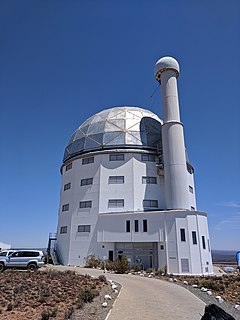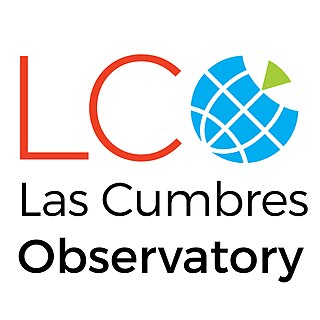
The Southern African Large Telescope (SALT) is a 10-metre class optical telescope designed mainly for spectroscopy. It consists of 91 hexagonal mirror segments each with a 1-metre inscribed diameter, resulting in a total hexagonal mirror of 11.1 by 9.8 m. It is located close to the town of Sutherland in the semi-desert region of the Karoo, South Africa. It is a facility of the South African Astronomical Observatory, the national optical observatory of South Africa.

Union Observatory also known as Johannesburg Observatory (078) is a defunct astronomical observatory in Johannesburg, South Africa that was operated between 1903 and 1971. It is located on Observatory Ridge, the city's highest point at 1,808 metres altitude in the suburb Observatory.

The Indian Astronomical Observatory (IAO), located in Hanle near Leh in Ladakh, India, has one of the world's highest located sites for optical, infrared and gamma-ray telescopes. It is operated by the Indian Institute of Astrophysics, Bangalore. It is currently the tenth highest optical telescope in the world, situated at an elevation of 4,500 meters (14,764 ft).

South African Astronomical Observatory (SAAO) is the national centre for optical and infrared astronomy in South Africa. It was established in 1972. The observatory is run by the National Research Foundation of South Africa. The facility's function is to conduct research in astronomy and astrophysics. The primary telescopes are located in Sutherland, which is 370 kilometres (230 mi) from Observatory, Cape Town, where the headquarters is located.

George Robert Carruthers was an African American inventor, physicist, engineer and space scientist. Carruthers perfected a compact and very powerful ultraviolet camera/spectrograph for NASA to use when it launched Apollo 16 in 1972. He designed it so astronauts could use it on the lunar surface, making all adjustments inside their bulky space suits. Upon instructions from Carruthers, they used the camera to record the Earth's outermost atmosphere, noting its variations, and also mapped portions of the far-ultraviolet sky recording stars and galaxies, and the gaseous media between them. In 1970, sending his instruments aboard Aerobee sounding rockets, he had demonstrated that molecular hydrogen exists in the interstellar medium. Among numerous citations and awards, in 2003, Carruthers was inducted into the National Inventor's Hall of Fame. He received an honorary doctorate for Engineering from Michigan Technological University, and in 2013 the 2012 National Medal for Technology and Invention from President Barack Obama.

Radcliffe Observatory was the astronomical observatory of the University of Oxford from 1773 until 1934, when the Radcliffe Trustees sold it and built a new observatory in Pretoria, South Africa. It is a Grade I listed building. Today, the observatory forms a part of Green Templeton College of the University of Oxford.

Thebe Rodney Medupe is a South African astrophysicist and founding director of Astronomy Africa. He is perhaps best known for his work on the Cosmic Africa project that attempts to reconcile science and myth.

Sutherland is a town with about 2,841 inhabitants in the Northern Cape province of South Africa. It lies in the western Roggeveld Mountains in the Karoo.

Las Cumbres Observatory (LCO) is a network of astronomical observatories run by a non-profit private operating foundation directed by the technologist Wayne Rosing. Its offices are in Goleta, California. The telescopes are located at both northern and southern hemisphere sites distributed in longitude around the Earth. For some astronomical objects, the longitudinal spacing of telescopes allows continuous observations over 24 hours or longer. The operating network currently consists of two 2 meter telescopes, nine 1 meter telescopes, and seven 40 cm telescopes, placed at six astronomical observatories. The network operates as a single, integrated, observing facility, using a software scheduler that continuously optimizes the planned observing schedule of each individual telescope.

The University of Illinois Astronomical Observatory, located at 901 S. Mathews Avenue in Urbana, Illinois, on the campus of the University of Illinois Urbana-Champaign, was built in 1896, and was designed by Charles A. Gunn. It has been listed on the National Register of Historic Places since November 6, 1986, and on December 20, 1989, was designated a National Historic Landmark.
The Kilodegree Extremely Little Telescope is an astronomical observation system formed by two robotic telescopes that are conducting a survey for transiting exoplanets around bright stars. The project is jointly administered by members of Ohio State University Department of Astronomy, the Vanderbilt University Department of Physics and Astronomy Astronomy Group, the Lehigh University Department of Physics, and the South African Astronomical Observatory (SAAO).

The SAAO Library is the national library of the South African Astronomical Observatory (SAAO) for astronomy and space science located in Observatory, Cape Town, South Africa. Its primary function is to conduct fundamental research in astronomy and astrophysics. The SAAO library can be seen as the integral part of the facility as it provides the research staff with access to essential information and tools that allow them to function as informed professionals within their community..
Bernard Lewis Fanaroff is a South African astronomer and trade unionist. He served in several positions in the South African government from 1994 to 2000 related to the Reconstruction and Development Programme, the RDP, and to Safety and Security.From 2003 to 2015 he led South Africa's bid to host the Square Kilometre Array Radio Telescope, the SKA, in Africa and the design and construction of the MeerKAT radio telescope. He is the co-developer of the Fanaroff–Riley classification, a method of classifying radio galaxies. He was the Project Director of South Africa's Square Kilometre Array bid.

Warrick John Couch is an Australian professional astronomer. He is currently a professor at Swinburne University of Technology in Melbourne. He was previously the Director of Australia's largest optical observatory, the Australian Astronomical Observatory (AAO). He was also the President of the Australian Institute of Physics (2015–2017), and a non-executive director on the Board of the Giant Magellan Telescope Organization. He was a founding non-executive director of Astronomy Australia Limited.
Kevin Govender is the director of The Office of Astronomy for Development and the joint recipient of the prestigious Edinburgh Medal together with the International Astronomical Union (IAU). The award was presented in recognition of the creation and practical establishment of the IAU Office of Astronomy for Development, which integrates the pursuit of scientific knowledge with social development for and with those most in need
Science tourism is a travel topic grouping scientific attractions. It covers interests in visiting and exploring scientific landmarks, including museums, laboratories, observatories and universities. It also includes visits to see events of scientific interest, such as solar eclipses.

Kai Kruse Staats is a filmmaker, science researcher, writer, and entrepreneur.

Norio Kaifu was a Japanese astronomer. He was best known as the president of the International Astronomical Union (IAU) from 2012 to 2015. He directed the Subaru telescope project, which housed the largest monolithic primary mirror in the world from its commission until 2005. Kaifu researched in radio astronomy, extragalactic astronomy, cosmic magnetic fields, non-stable stars, and infrared astronomy. The minor planet 6412 Kaifu is named in honor of him.
Dara J. Norman is an astronomer and the Deputy Director of the Community Science and Data Center at the National Science Foundation's National Optical-Infrared Astronomy Research Laboratory (NOIRLab) in Tucson, Arizona. She is also the Association of Universities for Research in Astronomy Diversity Advocate at NOAO. Her research centers on the influence of Active Galactic Nuclei (AGN) on the evolution of galaxies. In 2020, she was inducted into the inaugural cohort of American Astronomical Society Fellows in recognition of her leadership and achievements.